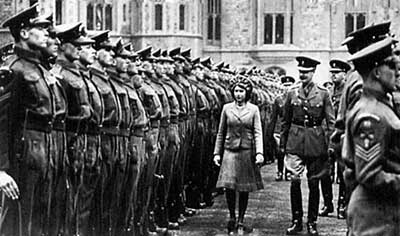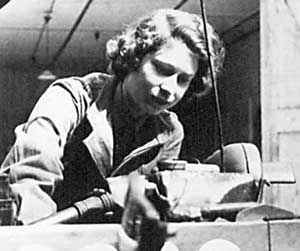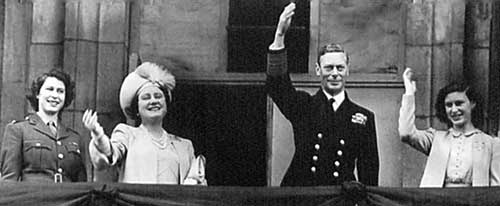|
Home | About Us | Subscribe | Advertise | Other Publications | Diary | Offers | Gallery | More Features | Obituaries | Contact
|
|
|
|
|
||||||||
The Duke of Connaught, who had been Colonel of the Grenadier Guards since 1904, died aged 91 on 16th January 1942. He was the great-great uncle and godfather of Princess Elizabeth, and the suggestion that she should be invited to take his place was met with immediate acclaim by the Regiment. She was nearly sixteen and her appointment as Colonel on 24th February signified her emergence from private to public life. To mark the occasion, the Regiment presented the Princess on her sixteenth birthday with a blue enamel and diamond brooch in the form of the Regimental Cypher. It was presented on 21st April, just before a parade of detachments from all eight Battalions of the Regiment at Windsor. The Princess in her reply spoke of her pride in the Regiment that she had already learnt to love. Accompanied by The King and Queen, she took the salute from her new Regiment on her first public engagement. Throughout the war the Royal Family refused to move to greater safely than their subjects, and a company of the Training Battalion provided their protection at Windsor Castle. It was reported that Princess Elizabeth attended a soldiers’ dance, closely chaperoned and with all her dancing partners carefully lined up and instructed. However, a young drummer, of about her age, boldly crossed the floor, came straight up to her and asked her to dance. She accepted graciously and they had a delightful turn around the floor. He brought her back and dismissed himself with perfect courtesy.
6th Battalion, Grenadier Guards, was raised at Caterham Barracks in October 1941. From the start they were a motor battalion suited for operations in desert warfare. In May 1942 the Battalion, the youngest of the Regiment, was honoured by the first visit which their new Colonel had paid to any of her battalions. On 14th June they left Caterham for Liverpool on the first stage of the journey to join 201st Guards Brigade in the Middle East. 4th Battalion’s training for armoured warfare had involved a major transformation. In 1943 they were re-equipped with Churchill tanks and were visited by Princess Elizabeth on 13th April on Salisbury Plain, her first solo public engagement, The Battalion, as part of 6th Guards Tank Brigade, set sail for France in July 1944. Princess Elizabeth was presented with her Colonel’s Colour on 21st April 1944, her eighteenth birthday. 1st Battalion was billeted at Hove and 2nd Battalion at Brighton as part of the Guards Armoured Division. Both were completing their final preparations for the invasion and landings on the Normandy beaches in June. On 17th May, Princess Elizabeth made her first inspection as Colonel. A site was found on a sports pitch on top of the steep hill overlooking Hove and the sea. The Welsh Guards Corps Of Drums provided the music. At 11am the 1st Battalion was drawn up in review order for inspection. The Colonel was greeted by a Royal Salute, and then walked along the ranks, speaking to all the officers and many of the old soldiers. The Battalion finally marched past, after which the officers of both Battalions entertained their Colonel to lunch at the Dudley Hotel. In the afternoon she inspected 2nd Battalion, while 1st Battalion lined the streets for her departure. In March 1944, due to casualties and the lack of reinforcements, there were insufficient Grenadiers to maintain six battalions, and 6th Battalion was removed from operations. The majority of officers and men were transferred to reinforce the 5th Battalion and to provide a pool of reserves. A nucleus of eight officers and one hundred other ranks sailed from Naples to England. They were welcomed home at Windsor by Princess Elizabeth. At the beginning of May, the veterans of Mareth and Monte Camino mounted The King’s Guard at Buckingham Palace. The Battalion was formally disbanded at the end of the year. In December 1944, 1st, 2nd, and 4th Battalions spent Christmas close to the German frontier and were involved in blocking the Ardennes offensive. However, every single man sat down to a Christmas dinner of pork, roast beef and tinned turkey, with at least three vegetables, and Christmas puddings provided by Princess Elizabeth. For the same reasons that had led to the disbandment of the 6th Battalion, the 5th Battalion followed. In March 1945 the nucleus left Naples, docked at Birkenhead and was taken to Chelsea Barracks, where all ranks were sent on three weeks’ leave. When they reassembled it was to wind up the Battalion formally at a parade in Wellington Barracks on 7th May, which was inspected by Princess Elizabeth. Four days later, 5th Battalion was officially disbanded. It was the eve of the end of the war in Europe.
In 1945 Princess Elizabeth convinced her father that she should be allowed to contribute directly to the war effort. She joined the Auxiliary Territorial Service (ATS), where she was known as Second Subaltern Elizabeth Windsor. Her training was with No 1 MT Training Centre at Camberley. She qualified as a driver and mechanic and was promoted to Junior Commander. On VE Day, 8th May 1945, Princess Elizabeth appeared in ATS uniform, with her parents, sister and Winston Churchill on the balcony of Buckingham Palace. A few weeks later the war was over. During the celebrations on VJ Day, she and her sister, escorted by three Grenadier officers, slipped incognito into the enormous crowds celebrating in Trafalgar Square and Piccadilly. They ended up outside Buckingham Palace calling for The King and Queen to appear on the balcony. Princess Elizabeth became Colonel of the Grenadier Guards in wartime aged sixteen. As Queen, she then became the Regimental Colonel-in-Chief. Her Platinum Jubilee in 2022 marked 70 years on the throne and 80 years as a Grenadier, a record that is unlikely to be surpassed, and The Queen’s close personal interest in the Grenadiers has remained undiminished throughout that long period. Prince Philip marked forty-two years as Colonel when he stood down in 2017. The historical attachment of Grenadiers to the person of their Monarch could hardly have endured in a more decisive form.
|
||||||||
|
||||||||





